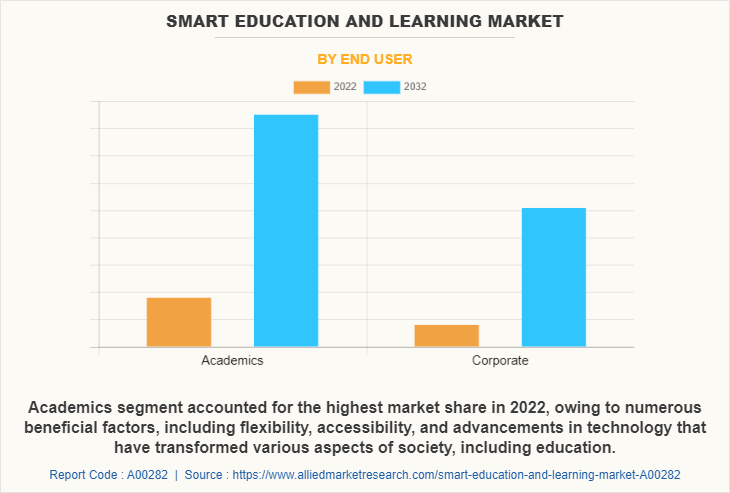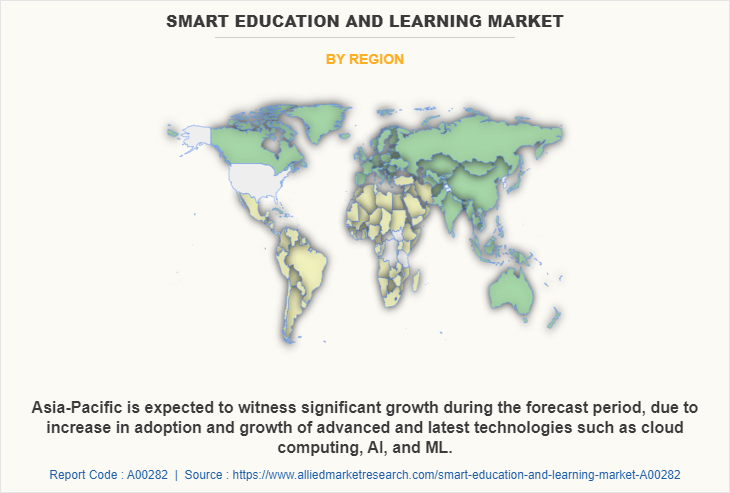Smart Education and Learning Market Statistics, 2032
The global smart education and learning market was valued at $260 billion in 2022, and is projected to reach $1.4 trillion by 2032, growing at a CAGR of 18.4% from 2023 to 2032.
Surge in demand for online and remote learning tools and favorable government initiatives and corporate fundings to promote smart education drive the growth of the market. In addition, the increase in need for interactive and personalized learning environments is fueling the smart education and learning market growth. However, lack of digital literacy and skills and data privacy and security concerns limits the growth of this market. Conversely, rise in implementation of AR and VR technology in the education sector is anticipated to provide numerous opportunities for the expansion of the market during the forecast period.

Smart education and learning refer to the integration of technology into the education process to enhance teaching and learning experiences. It involves the use of digital tools, online platforms, virtual classrooms, adaptive learning systems, and other technological advancements to facilitate personalized and interactive learning environments. This technology breaks down geographical barriers and provides access to education regardless of location. Online platforms, mobile learning apps, and virtual classrooms enable learners to access educational content and resources from anywhere, expanding educational opportunities for those in remote or underserved areas.
Segment Review
The global smart education and learning market is segmented into component, learning mode, end user, and region. Based on component, the market is divided into software, services, educational content, and hardware. On the basis of learning mode, it is categorized into virtual instructor-led training, simulation-based learning, social learning, blended learning, adaptive learning, and collaborative learning. By end user, it is divided into academics and corporate. Region-wise, it is analyzed across North America, Europe, Asia-Pacific, and LAMEA.

On the basis of end user, the academics segment dominated the smart education and learning market share in 2022 and is expected to continue this trend during the forecast period, as it addresses the specific needs and requirements of educational institutions to enhance the teaching and learning process. However, the corporate segment is expected to witness significant growth in the upcoming years, as it helps address this need by providing flexible and personalized training programs that cater to the specific skills required in the corporate world.

On the basis of region, the smart education and learning market size was dominated by Europe in 2022 and is expected to retain its position during the forecast period, owing to high demand for high-quality mobile services, extensive availability of fiber, and rise in penetration of the advanced technology are some of the driving factors in the region. However, Asia-Pacific is expected to witness significant growth during the forecast period, owing to the increase in demand for quality education and skills development, coupled with the rapid expansion of internet connectivity and mobile device adoption. Thus, such factors are expected to witness considerable growth during the forecast period.
The global smart education and learning industry is dominated by key players such as Adobe Systems Incorporated, Blackboard Inc, Cisco Systems, Inc, Desire2Learn Incorporated, Educomp Solutions Limited, Ellucian Company L.P, NIIT Limited, Saba Software, Inc, SMART Technologies Inc, Unit4 Business Software Ltd. These players have adopted various strategies to increase their market penetration and strengthen their position in the smart education and learning industry.
Top Impacting Factors
Rise in adoption of mobility and remote work
The rise in adoption of mobility and remote work has directly influenced the growth of the global cloud-based VDI market. The surge in trend of employees working from remote locations post-COVID and the need for seamless access to the work environment from any device have accelerated the demand for cloud-based VDI solutions. For instance, in September 2020, according to survey conducted by Organization for Economic Co-operation and Development (OECD), , Remote work has increased rapidly as a result of the pandemic, with more than half of the American workforce working from home.
In addition, 56% of hiring managers feel that the shift to remote work has gone better than expected. Furthermore, 61.9% of hiring managers stated that they are willing to rely more on remote work in the future. Radical advancements in desktop solutions, enabled through communication technologies, require revising present business models and maintenance strategies. Consequently, cloud-based VDI solutions are significantly adopted to increase the use of IT and control systems among virtual desktop operators, particularly IoT and other digital technologies. Cloud-based VDI enables employees to access virtual desktops, applications, and data from any location with an internet connection. This flexibility allows employees to work from home or from remote offices, empowering individuals to be productive regardless of their physical location. These aforementioned factors are likely to contribute to the increased installation of cloud-based VDI market, globally.
Furthermore, the integration of cloud-based VDI solutions allows multiple devices, including laptops, desktops, tablets, and smartphones, to run different operating systems. Individuals may use their preferred devices to access virtual desktops, providing a consistent user experience across various platforms. Hence, these multiple benefits offered by cloud-based VDI solutions are anticipated to boost the market demand.
Moreover, regional governments are continuously involved in promoting cloud solutions for virtual desktops. According to the State for Electronics and Information Technology, the Indian government has planned an incentive scheme to help domestic cloud-technology companies and startups challenge the supremacy of Microsoft Azure, Amazon Web Services, and Google Cloud. Such initiatives pooling in the digitalization of the virtual desktop is expected to fuel the demand for cloud-based VDI, which in turn is projected to augment market growth on a global scale.
Surge in expansion of cloud computing technology
The surge in the expansion of cloud computing technology is a key driver for the growth of the cloud-based VDI market. Cloud computing provides underlying infrastructure and resources required to deliver virtual desktops to end-users, making it an essential facilitating technology for cloud-based VDI solutions. This is attributed to the fact that various end-users are committing to adopt cloud based virtual desktop solutions as a part of digital transformation initiative. For instance, in April 2023, the Japanese government raised $31.7 million (4.2 billion yen) in funding to develop shared quantum computing using a business-friendly cloud platform.
The Japanese government intends to broaden quantum computing's accessibility so that businesses may take advantage of its benefits. Therefore, cloud-based VDI gained wider traction among end-users, taking advantage of cloud computing solutions in several industries. Moreover, cloud-based VDI leverages the economies of scale provided by cloud computing. Organizations may avoid the upfront costs associated with purchasing and maintaining on-premises hardware infrastructure. Consequently, regional governments and private & public businesses invest in cloud computing solutions.
For instance, in April 2023, Ericsson partnered with the Canadian Government to raise $352.40 million (CAD 470 million) in funding to enhance the presence of the global leaders in advanced 5G, 6G, AI, cloud RAN, and core network technologies. Such investment and advancements in cloud computing are expected to contribute to the growth of the global cloud-based VDI market.
Digital Capabilities
Virtual desktop infrastructure (VDI) is the creation and management of desktop environments and applications that allow employees to work and access applications and services outside the office, in the office, or from a remote location. Moreover, Since VDI makes virtual desktops easy to deploy and update from a centralized location, an increasing number of companies are implementing it for remote workers. Furthermore, VDI is an ideal solution for environments that allow or require employees to use their own devices. Since processing is done on a centralized server, VDI allows the use of a wider range of devices. It also offers better security, since data lives on the server and is not retained on the end client device. In addition, VDI uses server hardware to run desktop operating systems (OS) like Windows or Linux, or other software programs, on a VM with the desktop OS hosted on a centralized server in a physical datacenter.
End-User Adoption
The global cloud-based VDI market is expected to register high growth due to rise in focus of firms on digitization are expected to drive industry growth. Thus, increase in adoption of cloud-based VDI, owing to its rising smartphone penetration, soaring data telecommuting needs, surging demand for workforce productivity, are factors accelerating BYOD in the nation, particularly among industries like BFSI, telecom, media, and entertainment. Falling prices for GPU, SSDs and flash memories have also positively impacted the prices of the VDI solutions available in the market is one of the most significant factors driving the growth of the market. With surge in demand for cloud-based VDI, various companies have established alliances to increase their capabilities.
For instance, in March 202, Kasm Technologies partnered with Oracle Corporation to offer Workspaces for Oracle, a new Desktop-as-a-Service (DaaS), Remote Browser Isolation (RBI) and Containerized Application Streaming (CAS) solution. This innovative solution combines the benefits of the public cloud with the security and control of on-premises infrastructure, allowing enterprises to create cloud-based remote work solutions on-demand and at a global scale.
In addition, with further growth in investment across the world and the rise in demand for cloud-based VDI, various companies have expanded their current product portfolio with increased diversification among customers. For instance, in In September 2023, Stratodesk launched Stratodesk Managed Service Provider (MSP) program for MSPs and system integrators. The new program enables partners to offer complete services to provision and manage endpoints for hybrid workplaces.
Moreover, with the increase in competition, major market players have started collaborating companies to expand their market penetration and reach. For instance, January 2021, Cloud4C collaborated with Citrix to offer Citrix Virtual Apps and Desktops service for enterprises to leverage unmatched security and mobile workforce capabilities.
Key Benefits for Stakeholders
- This report provides a quantitative analysis of the market segments, current trends, estimations, and dynamics of the smart education and learning market forecast from 2023 to 2032 to identify the prevailing smart education and learning market opportunities.
- The market research is offered along with information related to key drivers, restraints, and opportunities.
- Porter's five forces analysis highlights the potency of buyers and suppliers to enable stakeholders make profit-oriented business decisions and strengthen their supplier-buyer network.
- In-depth analysis of the smart education and learning segmentation assists to determine the prevailing market opportunities.
- Major countries in each region are mapped according to their revenue contribution to the global market.
- Market player positioning facilitates benchmarking and provides a clear understanding of the present position of the market players.
- The report includes the smart education and learning market analysis of the regional as well as global smart education and learning market trends, key players, market segments, application areas, and market growth strategies.
Smart Education and Learning Market Report Highlights
| Aspects | Details |
| Market Size By 2032 | USD 1.4 trillion |
| Growth Rate | CAGR of 18.4% |
| Forecast period | 2022 - 2032 |
| Report Pages | 267 |
| By Component |
|
| By Learning Mode |
|
| By End User |
|
| By Region |
|
| Key Market Players | Saba Software, Inc., Unit4 Business Software Ltd., Educomp Solutions Limited, NIIT Limited, Desire2Learn Incorporated, Ellucian Company L.P, Adobe Inc., SMART Technologies Inc., Cisco Systems, Inc., Blackboard Inc. |
Analyst Review
Smart Education and Learning is characterized by adaptive and personalized learning approaches. It involves using technology to adapt educational materials, methods of instruction, and evaluations to the unique requirements and preferences of students. Smart education employs data-driven insights to understand strengths of the learner, weaknesses, and learning styles, enabling the delivery of customized learning pathways and experiences.
In addition, online assessments, automated grading, and data analytics provide timely and detailed feedback to learners, enabling them to track progress, identify areas for improvement, and receive personalized recommendations. Educators may also use data analytics to evaluate teaching strategies and optimize learning outcomes.
Key providers in the smart education and learning market are Adobe System, Inc., Educomp Solutions Ltd., and NIIT Limited. With the growth in demand for smart education and learning services, various companies have established partnerships to increase their solutions offerings in learning solutions. For instance, in September 2022, All-India Council for Technical Education (AICTE) partnered Adobe, to increase the capacity of the country for digital creation.
Adobe plans to offer training programs and professional development for teachers, as well as incorporate digital innovation into the curriculum. Such strategies contribute to driving the growth of the global market. In addition, with the surge in demand for smart education and learning, various companies have expanded their current product portfolio to continue with the rise in demand in the market.
For instance, in October 2021, SMART Technologies (SMART) launched a new library of videos, lesson activities, and resources, to create meaningful connections for students. It has improved the way students learn and the efficiency of institutions. For instance, in September 2021, Blackboard partnered with Busuu, this alliance brings personalized approach of Busuu to improve the language skills of students via Blackboard Assist, the tool within Blackboard Learn that links students to services and support they might need to achieve. This strategic partnership is expected to drive market growth
The smart education and learning market is estimated to grow at a CAGR of 18.4% from 2023 to 2032.
The Smart education and learning market is projected to reach $1,359.87 billion by 2032.
Surge in demand for online and remote learning tools and favorable government initiatives and corporate funding to promote smart education drive the growth of the market. In addition, the increase in need for interactive and personalized learning environment fuels the growth of the smart education and learning market. However, lack of digital literacy and skills and data privacy and security concerns limits the growth of this market. Conversely, rise in implementation of AR and VR technology in the education sector is anticipated to provide numerous opportunities for the expansion of the market during the forecast period.
The key players profiled in the report include Adobe Systems Incorporated, Blackboard Inc, Cisco Systems, Inc, Desire2Learn Incorporated, Educomp Solutions Limited, Ellucian Company L.P, NIIT Limited, Saba Software, Inc, SMART Technologies Inc, Unit4 Business Software Ltd.
The key growth strategies of Smart education and learning market players include product portfolio expansion, mergers & acquisitions, agreements, geographical expansion, and collaborations.
Loading Table Of Content...
Loading Research Methodology...



